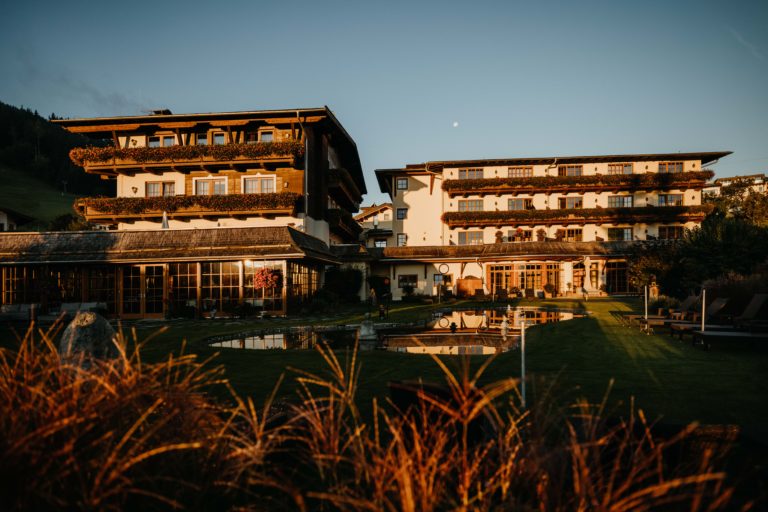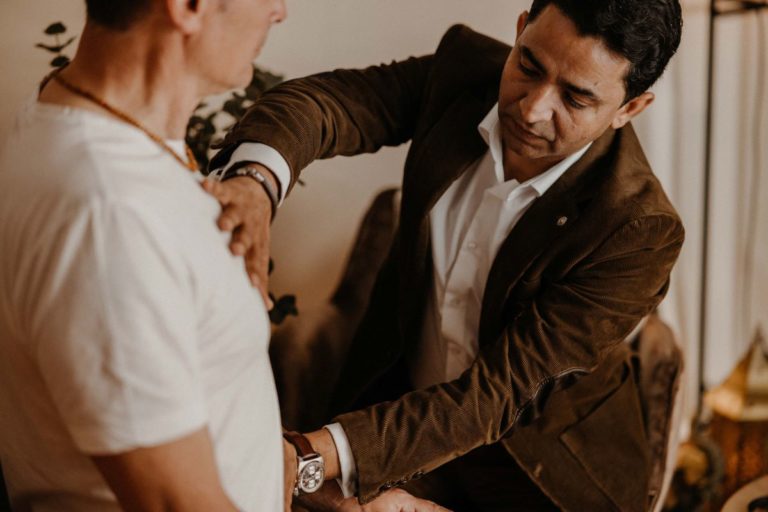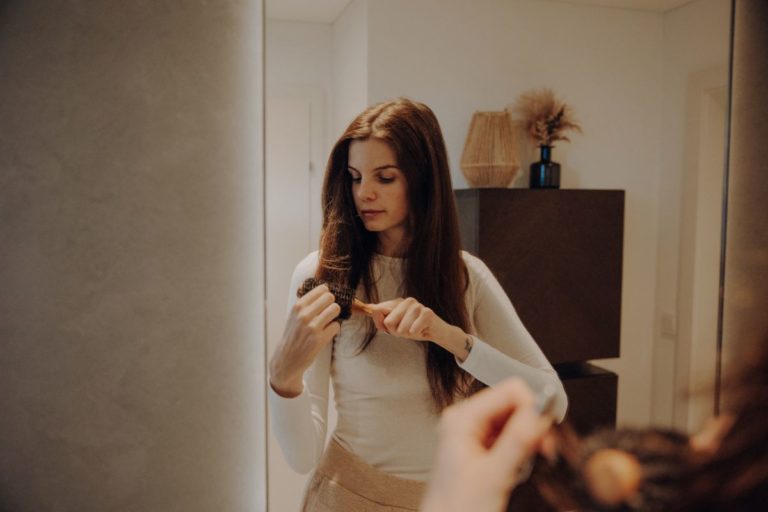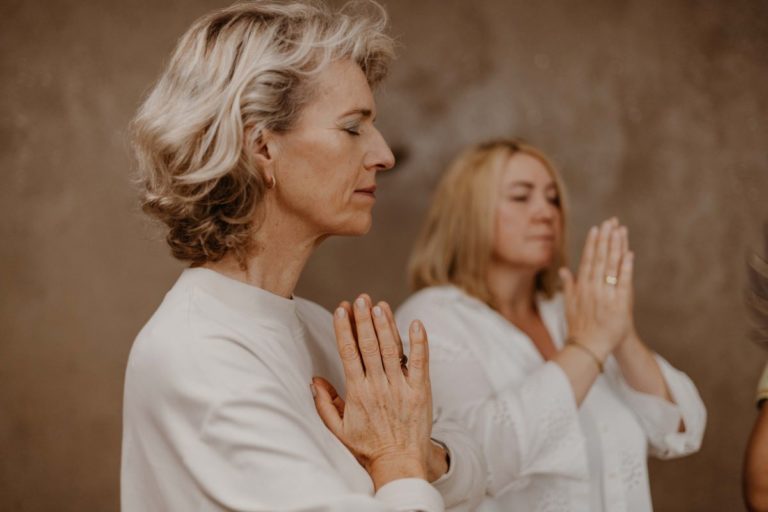The appearance of human skin reveals a lot about a person's health and feelings. You can tell whether you are living in harmony with yourself and your environment. A good work-life balance or a lot of stress are also reflected in the appearance of your skin. Here you can find out how Ayurvedic skincare can help you achieve radiantly beautiful and well-groomed skin.
What factors influence your skin?
From an Ayurvedic perspective, your complexion can be influenced with the help of the three most important pillars - nutrition, proper skin care and mental balance. Pitta bioenergy in particular is responsible for beautiful skin.
Pitta has its headquarters in the liver area, which requires the liver and duodenum to function well for beautiful and healthy skin. An imbalance of these organs and hormonal regulation leave their mark on the skin in the long term.
The different skin types in Ayurveda
Ayurveda differentiates between three different skin types according to the three constitutional types Vata, Pitta and Kapha. Your complexion varies depending on your Dosha, which gives an indication of which type you are. Take our Dosha test right here.
- Vata skin has fine pores, is dry, cold, pale, dull, rosy or brownish and is particularly sensitive to sunlight. To protect your skin, mild cleansing and intensive care are important for this type.
- Pitta skin is often reddish, warm, moist or oily and prone to inflammation (mainly due to poor diet). Freckles or moles are also characteristics of Pitta skin. Intensive cleansing as well as low-irritant, cooling and sebum-reducing skin care products are important for this skin type.
- Kapha skin is cool, dense, well moisturized, rather oily and large-pored. Regular cleansing is advisable here, although this skin type is the easiest to care for.
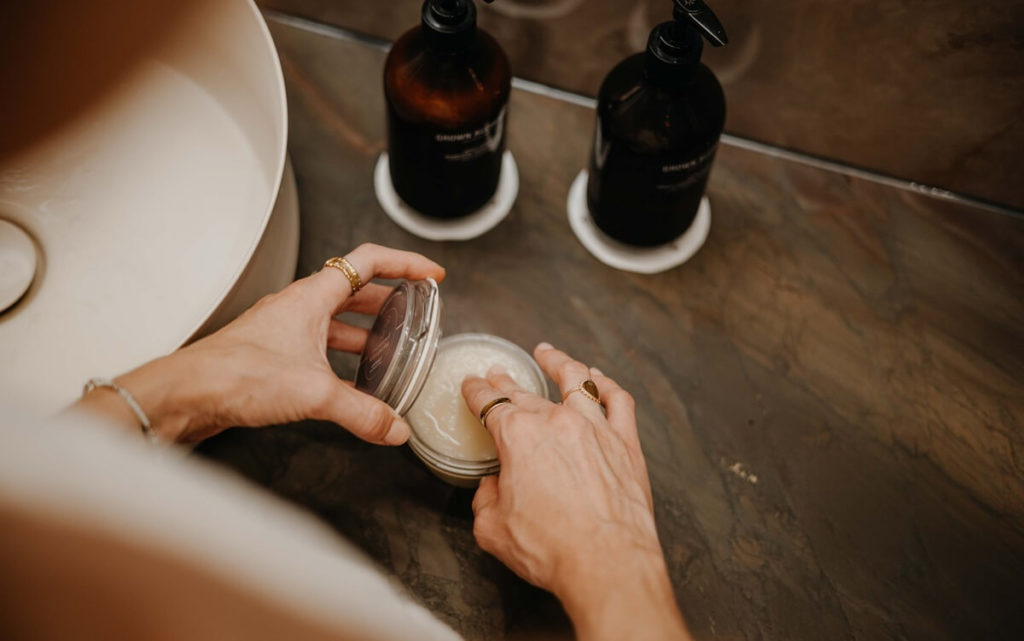

Discover the right skincare products for your dosha now
Naturally beautiful with Ayurveda! Make your skin glow with European Ayurveda® care products - tailored to your needs and your Dosha.
The right skin care for your constitutional type
It is best to adapt your skincare to the needs of your skin. Your dosha type can be helpful here.
Healing massages:
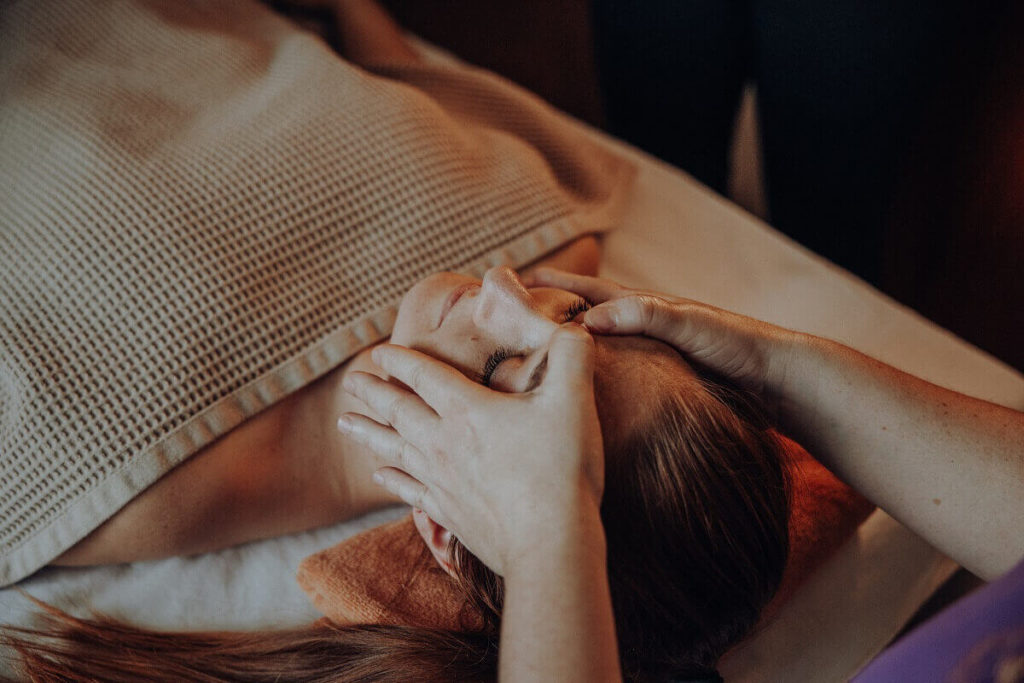

| Vata | - Warm sesame, avocado, olive, almond or walnut oil - Gentle, calming massage for more relaxation and vitalization of the Vata personality |
| Pitta | - Almond, coconut, sunflower, apricot kernel or olive oil - Soothes and cools the skin |
| Kapha | - Almond, rapeseed, safflower, grape seed or apricot kernel oil - Essential oils of lemon, cypress, lavender, clove, camphor or bergamot - Manual massage for lymphatic drainage and activation of skin metabolism |
Masks and compresses:
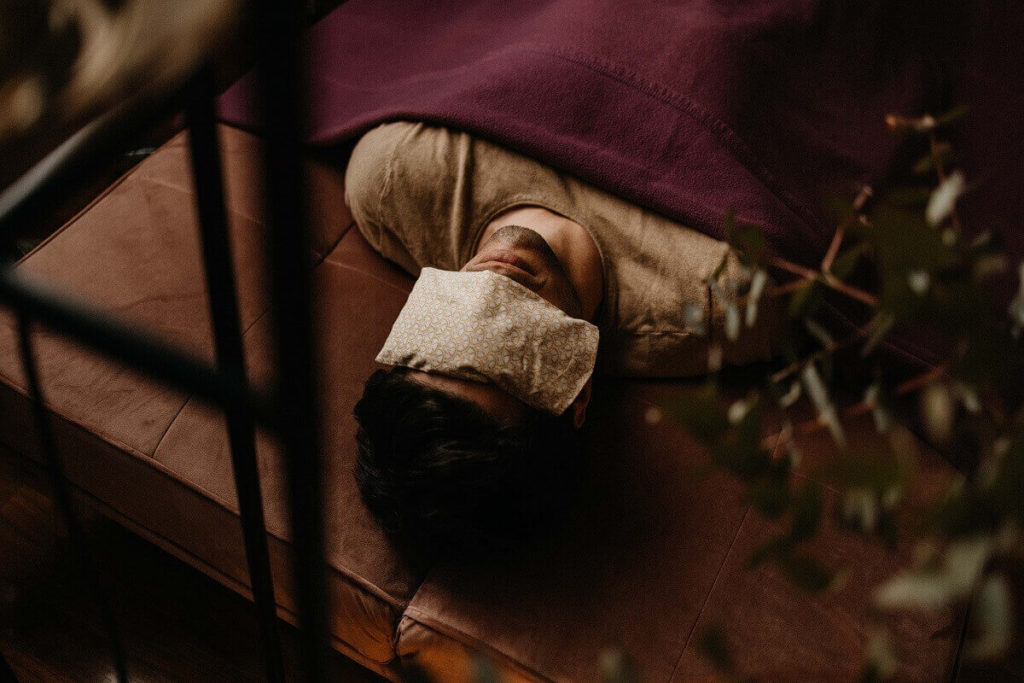

| Vata | - Warm compresses, sweating treatments and face masks with avocado, cream, banana, oatmeal, sandalwood powder and herbs such as jasmine and basil |
| Pitta | - Mask or compress of parsley, rose water, coriander, lotus, nard or lavender with yogurt or buttermilk |
| Kapha | - Hot compresses and steam baths with cistus water or medicinal herbs such as ginger, turmeric, neem and clary sage |
Proper nutrition:
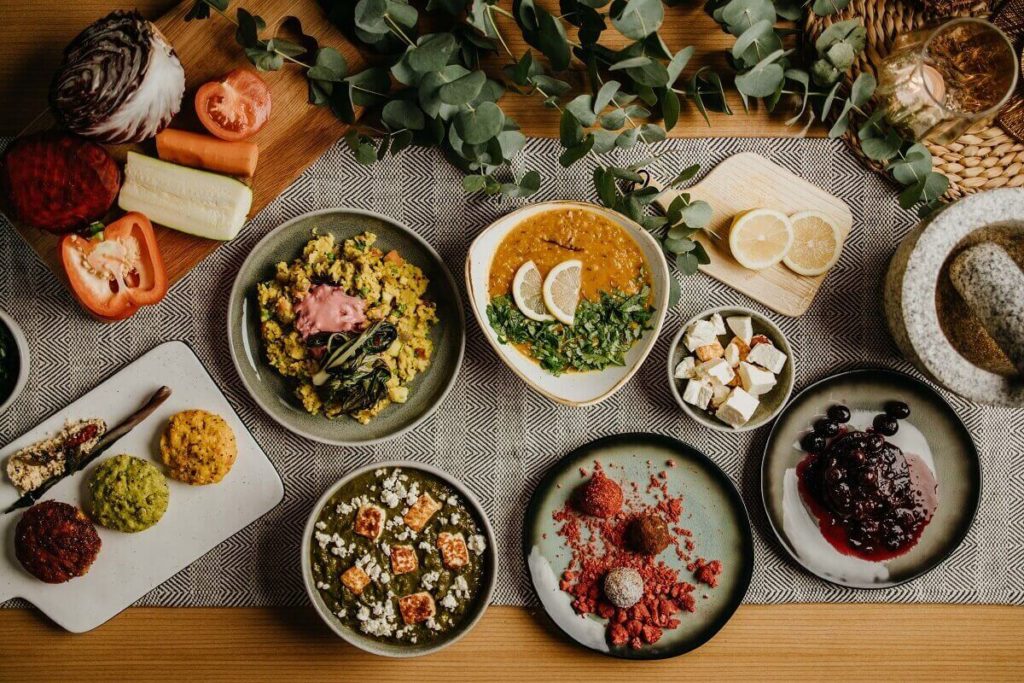

| Vata | - Natural sweet fruit juices - Warm, fresh soups with rice, spelt, potato, carrot, fennel and asparagus - Two tablespoons of olive oil daily with spices such as fennel, nutmeg, ginger and saffron |
| Pitta | - Mainly green, slightly bitter vegetables - Raw vegetables such as lettuce, artichokes, chard, endive, chicory and asparagus - Apples, millet, rice, potatoes - Spices such as cinnamon, cardamom, turmeric and coriander |
| Kapha | - Avoid fatty, fried, sour and salty foods - Increase hot and metabolism-stimulating spices such as pepper, ginger, chili, turmeric and garlic |
Food supplement:
With the right nutritional supplement, you can do your body and skin a lot of good. The following Ayurvedic medicinal plants promote the well-being of your skin, have an anti-inflammatory effect and prevent dryness and skin ageing (anti-ageing):
- Amalaki: antioxidant, cooling
- Chandana: cooling, calming, brightening
- Guduci: antioxidant, blood purifying
- Haridra: blood-purifying, anti-allergic
- Khadira: anti-eczematous, astringent
- Mandukaparni: cooling, wound healing, anti-inflammatory
- Manjishta: blood-purifying, pigment-correcting
- Nimba: antimicrobially effective against bacteria and fungi
- Sariva: soothes itching, regulates perspiration, anti-allergic
- Shallaki: anti-inflammatory, anti-allergic, anti-tumor
- Yashtimadhu: "ayurvedic cortisone", wound healing
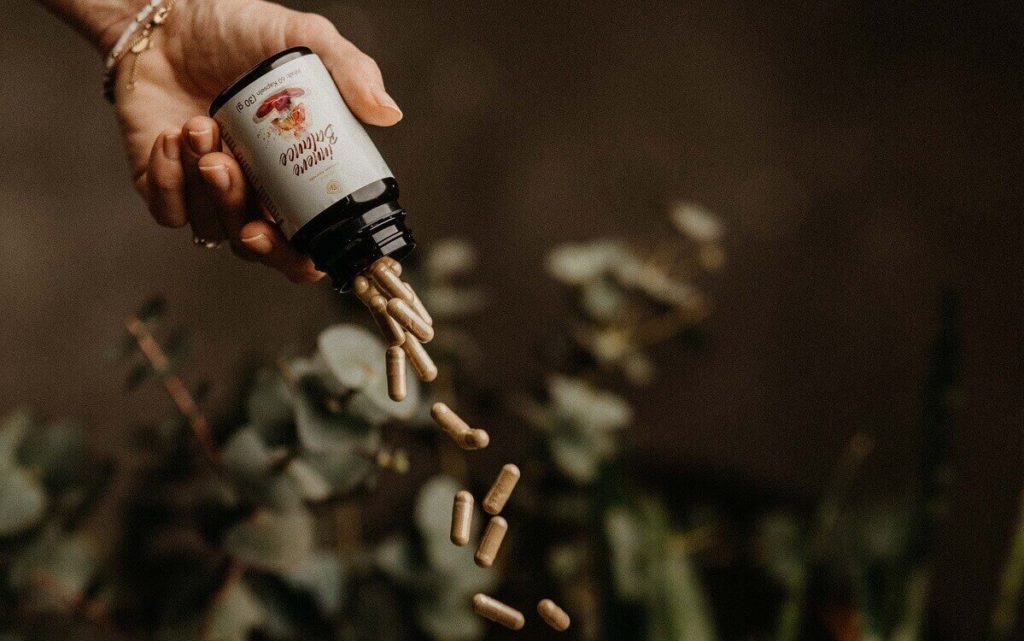

Discover high-quality nutritional supplements in our store now
To support a balanced diet, we recommend selected Ayurvedic food supplements and supplements.
The right care for radiantly beautiful and healthy skin
To keep your skin fresh and healthy, you should pay attention to several different factors. Inner health is at least as important as outer health. In addition to the nutrition tips, the following points will help you on your way to beautiful and radiant skin.
Tip #1: Skin care from the inside
Ayurvedic skin care is all about strengthening from within. With the right Ayurvedic diet tailored to your Dosha type, you can strengthen your individual digestive fire Agni.
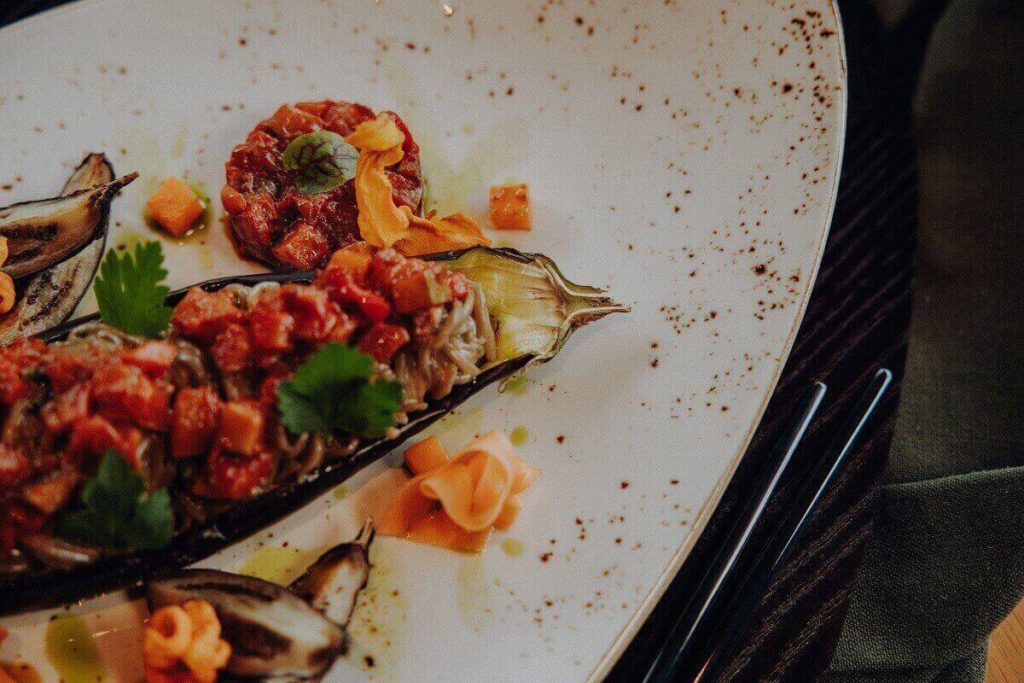

The following also applies to all constitution types:
- Eat wholesome and warm meals
- Eat regularly at fixed times: Breakfast by 9:00 a.m. at the latest, lunch between 12:00 and 1:00 p.m. and dinner between 6:00 and 7:00 p.m.
- Do not combine sweet and salty
- Eat lots of green leafy vegetables
- Adequate intake of vitamin C, e.g. from citrus fruits
- Absorption of high-quality fats and oils#
Tip #2: Take care of your liver
In Ayurveda, the liver is considered the key to healthy skin. It is not without reason that it is the central starting point when it comes to improving the appearance of the skin. The liver should also be treated as a first step in the event of skin complaints. If it is overloaded or out of balance, you can take appropriate measures.
On the one hand, you can take measures to detoxify and cleanse your body. A professional Ayurvedic detox cure, for example, helps with sustainable detoxification. A conscious intake of nutrients also has a positive effect on the liver.
Tip #3: Abhyanga massage against dryness
The Abhyanga massage is one of the most important Ayurvedic treatments for dry skin. It involves massaging the body with precious oils, ideally repeated daily.
It can also be performed as a self-massage. Coconut, castor, sesame or almond oil are ideal for the Abhyanga massage.
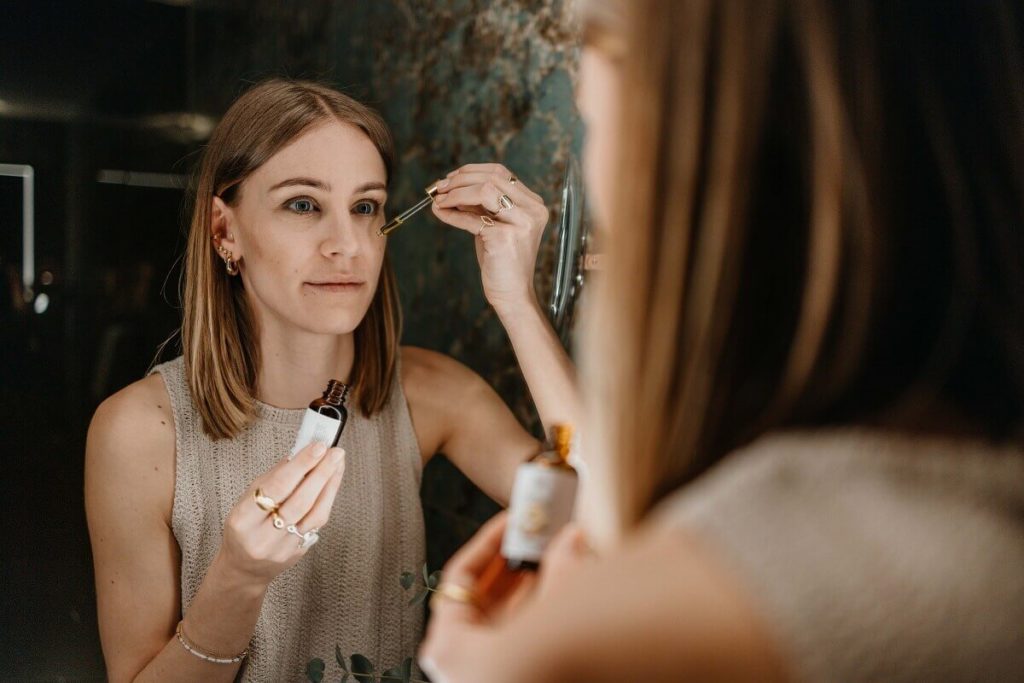

The oils work best against dryness if you warm them slightly in a water bath. Then massage them into your skin using even movements. After the oil has been absorbed for half an hour, you can wash it off. You can use Ayurvedic herbal oils up to twice a week to support your skin.
Tip #4: Daily, thorough cleansing of the skin
Thorough cleansing is an integral and important part of Ayurveda. A warm bath or shower cleanses your body and relaxes it. Kapha types in particular should pay attention to thorough cleansing, as bacteria and allergens adhere more easily to oily skin.
Tip #5: Best natural cosmetics for wonderfully nourished skin
You should also provide your skin with the right protection and care from the outside to keep it smooth and supple in the long term. Pamper your skin intensively with gentle Ayurvedic skincare products.
Tip #6: Get enough sleep
Another important part of Ayurveda is sleep - the time of regeneration. This applies to all areas of the body, including the skin, whose cells regenerate faster during sleep than during the day. A prolonged lack of sleep makes your skin thinner and prone to wrinkles.
Tip #7: Conscious relaxation
Make sure you consciously relax on a regular basis. Experience has shown that this works particularly well if you schedule fixed times for daily downtime. Yoga, breathing exercises and meditation are great ways to do this. A leisurely walk in the fresh air also helps you to relax.
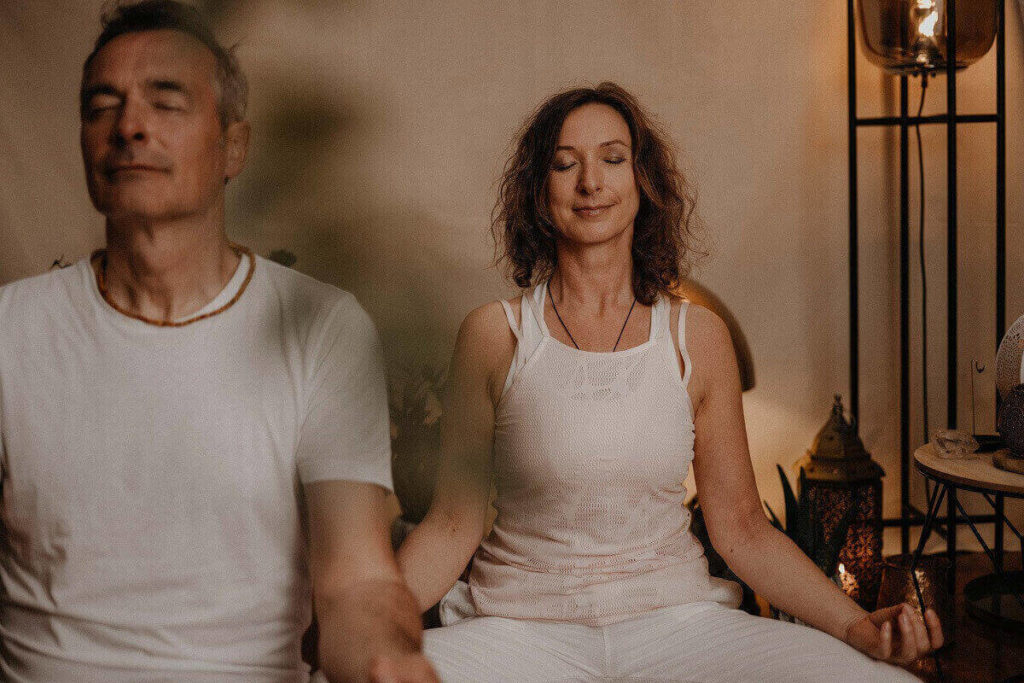

Tip #8: Daily exercise
Regular exercise promotes blood circulation in your skin and its supply of nutrients and oxygen. It also promotes the removal of waste products. In Ayurveda, sporting activities are preferably recommended between 06:00 and 10:00 in the morning.
Tip #9: Face masks as a pampering program for the skin
You should pamper your skin with a face mask once a week. An excellent choice for this is ayurvedic facial carewhich is suitable for use in the morning and evening and also serves as a nourishing mask. Again, make sure you use the right mask and cream for your dosha type.
Tip #10: Mindfulness & joie de vivre
Last but not least, it is important that you pay a lot of attention to your skin. This active attention not only has a positive effect on your body, but also on your entire attitude to life. This in turn influences your appearance - if you feel good all round, your skin will also glow.
Ayurvedic nutrition tips to strengthen your skin
As in many other Ayurvedic areas, a healthy lifestyle also has a lot to do with the skin. Your skin benefits sustainably froma healthy Ayurvedic diet. By eating the right foods, you provide your body with the right nutrients. These in turn ensure a smooth digestive and metabolic process.
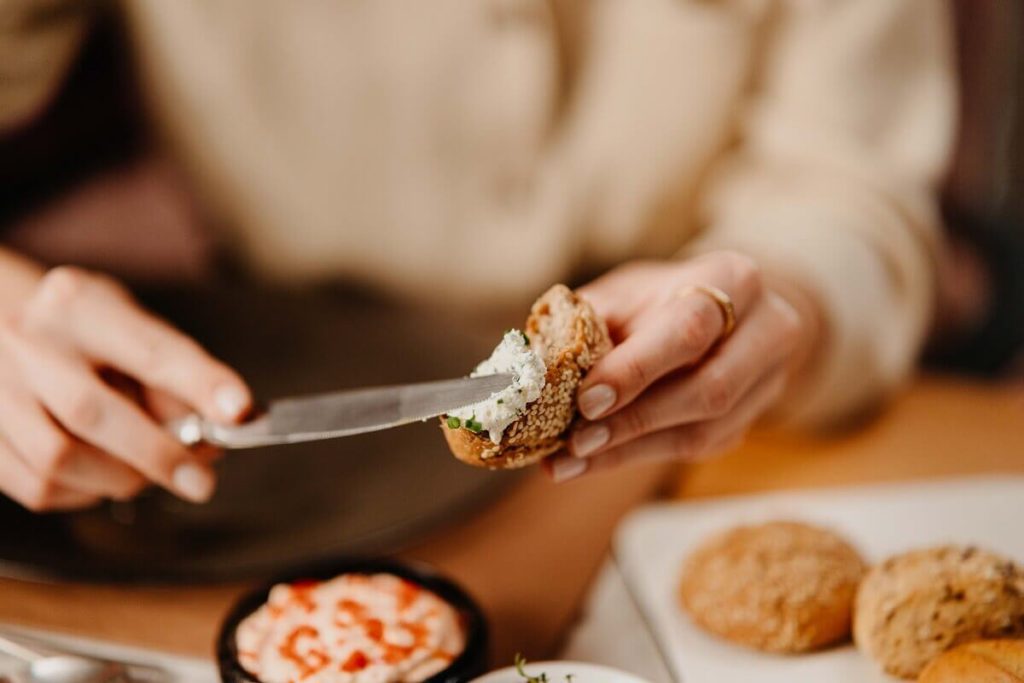

In Ayurveda, the right diet for your skin is basically vegetarian.
Foods and preparations that are good for your skin:
- Sweet and bitter foods
- Boiling, steaming or stewing
- Fresh steamed vegetables
- Fresh, sweet, seasonal and ripe fruit (apples, grapes, pears, melons)
- Fresh, bitter lettuce (endive, chicory, radicchio, dandelion)
- Cooked pulses (especially mung dal)
- Cooked cereals (rice, quinoa, spelt, oats, wheat)
- High-quality and stable fats (ghee, coconut oil, olive oil)
- Only pasteurized cow's milk and cream (organic)
- Mild, digestive spices (ginger, turmeric, coriander, cardamom)
Foods and preparations that are best avoided:
- Very acidic foods
- Frying, roasting, baking, grilling and deep-frying
- Red meat, dark fish and seafood
- Excessive alcohol
- Sunflower oil, safflower oil, sesame oil (because highly heated)
- Finished products or fermented products
- Excessively hot spices (chili, asafoetida, pepper)
- Too much salt
Ghee as a natural aid in Ayurvedic cuisine
Ghee is an integral part of Ayurvedic cuisine. The positive properties of clarified butter put other fats in the shade. It is not only suitable for gentle frying, but can also be used for health purposes.
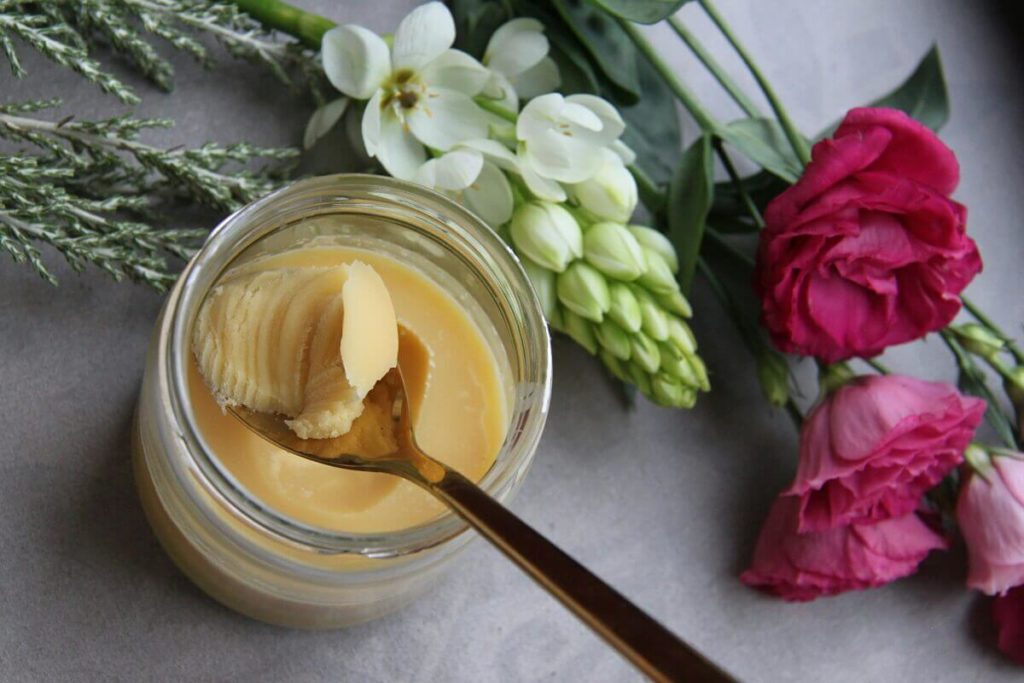

Ghee is basically nothing more than clarified butter with almost 100 percent fat content. During production, almost all of the water evaporates and animal proteins and lactose are released. The ghee takes on a rich yellow color and reaches a solid consistency.
The clarified butter is suitable for both internal and external use and has an anti-inflammatory effect. The ghee effect on your skin is shown by the prevention of the formation of scars or blisters and the reduction of redness.
Ghee can also be used for the treatment of psoriasis. In Ayurvedic medicine, ghee is also used against wrinkles , among other things. The high fat content helps your skin to absorb moisture and thus reduce wrinkles.
It is also suitable for removing make-up in the evening, for example. The fat not only dissolves the make-up, but also cares for your skin at the same time. Ghee is also ideal for massages.
Causes of skin diseases
As already mentioned, skin diseases have different causes. They can be caused by diet or be the result of a disturbed metabolism .
Ayurveda considers the following criteria to be the cause of diseased skin:
- Too much fresh cereal, yogurt, fish, salty and sour foods
- Too much urid dal, radish, sesame, milk, cookies and jaggery
- Foods that are difficult to digest, fatty or heavy
- Suppression of natural needs, such as nausea and vomiting
- Cold water after intense heat, physical exertion or stressful situations
- Physical exertion in intense heat or after a heavy meal
- Ingestion of uncooked food before the previous meal has been digested
- Sexual activity with poor digestion
- Incorrect execution of Panchakarma
- Daytime sleep
During a professional Ayurveda treatment, an Ayurveda expert can help you to read your skin symptoms and categorize them into the three categories Vataja Kushta, Pittaja Kushta and Kaphaja Kushta. The results are then used to create an individual disease progression (Samprapti). Based on this, a suitable therapy concept is developed.
How does Ayurveda help against acne?
Acne has various origins, which can range from food intolerances to medical causes. In addition to hormonal reasons, your diet and lifestyle also play an important role. With the right Ayurvedic treatment, you can see results quickly, as the treatment is tailored to your individual needs.
It is important that you eat a balanced diet to provide your body - and your skin - with all the important nutrients, vitamins and minerals. You should consistently avoid foods that have a negative effect on your body. Fresh and unprocessed foods will strengthen you and your body in the long term.
Ayurveda takes a look at your lifestyle habits when it comes to treating acne. Factors such as sleep patterns, exercise and good stress management can influence the appearance of your skin.
Exercise promotes blood circulation and supplies your skin with oxygen. Yoga, breathing and meditation techniques are also Ayurvedic approaches to treating acne naturally.
Conclusion: Mindfulness and the right diet for beautiful skin
Beautiful skin comes from within! In Ayurveda, skin care is therefore considered holistically and specifically tailored to your dosha type. Pay attention to a dosha-appropriate diet so that your digestive fire Agni is in balance.
Balance and mindfulness for yourself and your own body are also important. Sufficient sleep, regular relaxation and plenty of exercise have a significant impact on the appearance of your skin.
Together with daily, thorough cleansing and the right skin care with Ayurvedic natural cosmetics, face masks and soothing massages with oil, this will really make your skin glow!
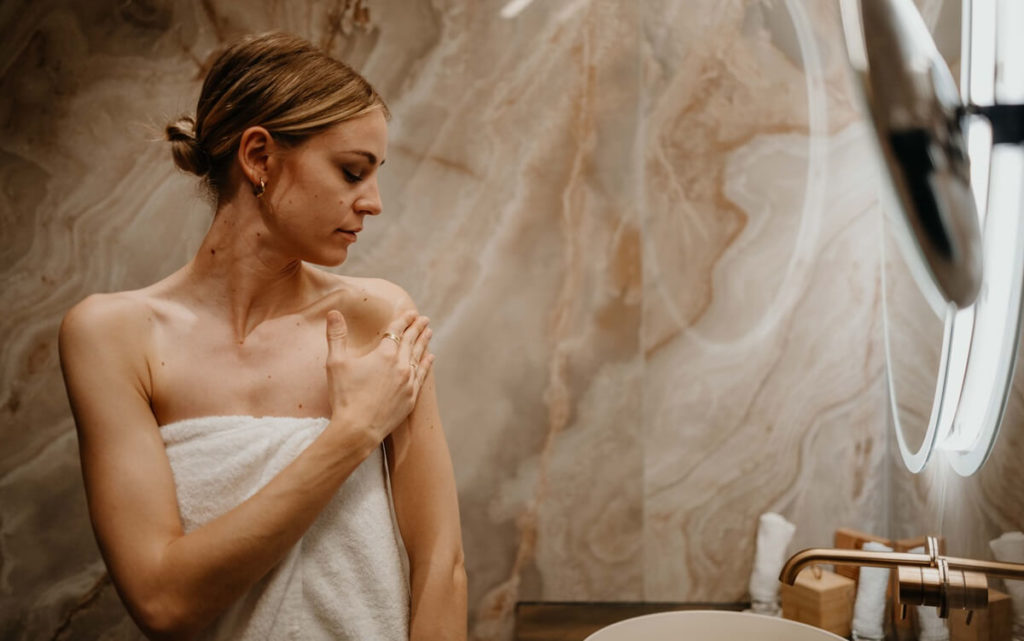

5 tips on how to improve your complexion in the long term
The skin is the largest human organ. It protects us from the sun, cold and pathogens and requires appropriate care. With a healthy lifestyle and the right care, you can improve the appearance of your skin in the long term.

